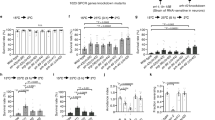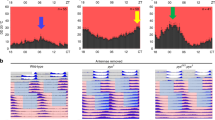Abstract
In animals such as the fruitfly, even minor deviations in environmental temperature can have major impacts on development and lifespan. Here we demonstrated that the ability of Drosophila melanogaster larvae to discriminate between the optimal temperature of 18 °C and slightly higher temperatures (19–24 °C) depended on the TRPA1 channel, which functioned downstream of a phospholipase C–dependent signaling cascade similar to that used in fly phototransduction. We propose that activation of TRPA1 through a signaling cascade promotes amplification of small differences in temperature and facilitates adaptation to temperatures within the comfortable range.
This is a preview of subscription content, access via your institution
Access options
Subscribe to this journal
Receive 12 print issues and online access
$209.00 per year
only $17.42 per issue
Buy this article
- Purchase on Springer Link
- Instant access to full article PDF
Prices may be subject to local taxes which are calculated during checkout


Similar content being viewed by others
References
Venkatachalam, K. & Montell, C. Annu. Rev. Biochem. 76, 387–417 (2007).
Rosenzweig, M. et al. Genes Dev. 19, 419–424 (2005).
Lee, Y. et al. Nat. Genet. 37, 305–310 (2005).
Tracey, W.D., Wilson, R.I., Laurent, G. & Benzer, S. Cell 113, 261–273 (2003).
Viswanath, V. et al. Nature 423, 822–823 (2003).
Montell, C. & Rubin, G.M. Neuron 2, 1313–1323 (1989).
Bloomquist, B.T. et al. Cell 54, 723–733 (1988).
Wang, T. & Montell, C. Pflugers Arch. 454, 821–847 (2007).
Kwon, Y. & Montell, C. Curr. Biol. 16, 723–729 (2006).
Scott, K., Becker, A., Sun, Y., Hardy, R. & Zuker, C. Neuron 15, 919–927 (1995).
Kalidas, S. & Smith, D.P. Neuron 33, 177–184 (2002).
Steele, F.R., Washburn, T., Rieger, R. & O'Tousa, J.E. Cell 69, 669–676 (1992).
Vinós, J., Jalink, K., Hardy, R.W., Britt, S.G. & Zuker, C.S. Science 277, 687–690 (1997).
Acknowledgements
This work is dedicated to the memory of Bae Gyo Jung. We thank M.-K. Chung for helpful suggestions. This work was supported by grants from the US National Eye Institute (EY010852) and US National Institute of General Medical Sciences (GM085335).
Author information
Authors and Affiliations
Contributions
Y.K. and C.M. designed the experimental plan, analyzed the data and prepared the manuscript. C.M. also supervised the research and obtained the funding for this study. Y.K. and H.-S.S. conducted the behavioral assays. Y.K. also generated the trpA11 mutant and performed the GFP localization studies. X.W. generated the wtrw1 mutant. H.-S.S. and X.W. also helped analyze the data and improved the manuscript with their comments.
Corresponding author
Supplementary information
Supplementary Text and Figures
Supplementary Figures 1–4, Supplementary Tables 1–9 and Supplementary Methods (PDF 3454 kb)
Rights and permissions
About this article
Cite this article
Kwon, Y., Shim, HS., Wang, X. et al. Control of thermotactic behavior via coupling of a TRP channel to a phospholipase C signaling cascade. Nat Neurosci 11, 871–873 (2008). https://doi.org/10.1038/nn.2170
Received:
Accepted:
Published:
Issue Date:
DOI: https://doi.org/10.1038/nn.2170
This article is cited by
-
G protein-coupled receptor-based thermosensation determines temperature acclimatization of Caenorhabditis elegans
Nature Communications (2024)
-
Genes associated with hot defensive bee ball in the Japanese honeybee, Apis cerana japonica
BMC Ecology and Evolution (2022)
-
Interspecies variation of larval locomotion kinematics in the genus Drosophila and its relation to habitat temperature
BMC Biology (2021)
-
Opsins outside the eye and the skin: a more complex scenario than originally thought for a classical light sensor
Cell and Tissue Research (2021)
-
OSM-9 and OCR-2 TRPV channels are accessorial warm receptors in Caenorhabditis elegans temperature acclimatisation
Scientific Reports (2020)



